Victorian Fashion Victorian Vs Edwardian Fashion


Analogy depicting fashions throughout the 19th century
Victorian fashion consists of the diverse fashions and trends in British civilisation that emerged and developed in the United Kingdom and the British Empire throughout the Victorian era, roughly from the 1830s through the 1890s. The menses saw many changes in fashion, including changes in styles, fashion technology and the methods of distribution. Various movement in compages, literature, and the decorative and visual arts likewise as a changing perception of gender roles also influenced fashion.
Under Queen Victoria's reign, England enjoyed a period of growth along with technological advancement. Mass production of sewing machines in the 1850s likewise as the advent of synthetic dyes introduced major changes in fashion.[one] Clothing could exist made more quickly and cheaply. Advocacy in printing and proliferation of fashion magazines immune the masses to participate in the evolving trends of high style, opening the market of mass consumption and advertizing. Past 1905, vesture was increasingly factory made and oftentimes sold in large, stock-still-price department stores, spurring a new age of consumerism with the rise middle form who benefited from the industrial revolution.[one]
Women's fashions
During the Victorian Era, women more often than not worked in the private, domestic sphere.[2] Unlike in earlier centuries when women would frequently help their husbands and brothers in family unit businesses and in labour, during the nineteenth century, gender roles became more defined. The requirement for subcontract labourers was no longer in such a loftier need after the Industrial Revolution, and women were more likely to perform domestic work or, if married, requite up work entirely. Dress reflected this new, increasingly sedentary lifestyle, and was not intended to be utilitarian.
Clothes were seen every bit an expression of women's place in lodge,[3] hence were differentiated in terms of social form. Upper-class women, who did not need to work, oft wore a tightly laced corset over a bodice or chemisette, and paired them with a brim adorned with numerous embroideries and trims; over layers of petticoats. Middle-class women exhibited like clothes styles; however, the decorations were not as extravagant. The layering of these garments make them very heavy. Corsets were also stiff and restricted movement. Although the clothes were not comfy, the blazon of fabrics and the numerous layers were worn every bit a symbol of wealth.

Pic of 1850s evening dress with a bertha neckline
- Neck-line: Bertha is the depression shoulder neck-line worn by women during the Victorian Era. The cut exposed a woman's shoulders and it sometimes was trimmed over with a three to six-inch deep lace flounce, or the bodice has neckline draped with several horizontal bands of fabric pleats. However, the exposure of cervix-line was just restricted to the upper and heart course, working-grade women during the time period were not allowed to reveal then much mankind.
The décolleté manner made shawls to become an essential feature of dresses. Corsets lost their shoulder straps, and style was to produce two bodices, one closed décolletage for 24-hour interval and one décolleté for evening. - Boning: Corsets were used in women's gowns for emphasizing the pocket-size waist of the female person body. They part as an undergarment which can exist adjusted to bind tightly around the waist, hold and train a person's waistline, so to slim and conform it to a fashionable silhouette. Information technology also helped stop the bodice from horizontal creasing. With the corset, a very pocket-sized tight fitting waist would exist shown.
Corsets accept been blamed for causing many diseases considering of tight lacing, just the practice was less commonplace than by and large thought today (Effects of tightlacing on the body).

- Sleeves: Sleeves were tightly fit during the early Victorian era. It matched with the tight fit women's small waist in the design, and the shoulder sleeve seamline was drooped more to show a tighter fit on the arm. This somewhen express women'southward movements with the sleeves.
All the same, as crinolines started to develop in fashion, sleeves turned to exist like large bells which gave the dress a heavier book. Engageantes, which were usually made of lace, linen, or backyard, with cambric and broderie anglaise, were worn nether the sleeves. They were piece of cake to remove, launder and restitch into position, and so to act every bit false sleeves, which was tacked to the elbow-length sleeves during the fourth dimension. They ordinarily appear under the bell-shaped sleeves of day dresses. - Silhouette: Silhouette changed over time supported past the evolution of the undergarment. In before days, wide skirts were supported by fabrics like linen which used horsehair in the weave. Crinolines were used to give skirts a beehive shape, with at least half-dozen layers petticoats worn under the skirt, which could counterbalance equally much as fourteen pounds. Afterwards, the cage crinoline was developed. Women were freed from the heavy petticoats, and were able to movement their legs freely below the cage. Silhouette after began to emphasise a slope toward the back of the skirt. Polonaise fashion was introduced where fullness bunched upwards at the back of the brim. Crinolines and cages also started to disappear with information technology being more than dangerous to working-class women. Tournures or bustles were developed.
Victorian-era cosmetics were typically minimal, as makeup was associated with promiscuity. Many cosmetics contained toxic or caustic ingredients like atomic number 82, mercury, ammonia, and arsenic.
1830s dress fashion

During the commencement of Queen Victoria'south reign in 1837, the platonic shape of the Victorian woman was a long slim body emphasised by wide hips. To accomplish a low and slim waist, corsets were tightly laced and extended over the belly and downwards towards the hips.[4] A chemise was ordinarily worn under the corset, and cut relatively depression in guild to prevent exposure. Over the corset, was the tight-fitting bodice featuring a low waistline. Along with the bodice was a long skirt, featuring layers of horsehair petticoats[four] worn underneath to create fullness; while placing emphasis on the small waist. To contrast the narrow waist, low and straight necklines were thus used.
1840s dress mode
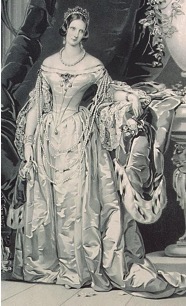
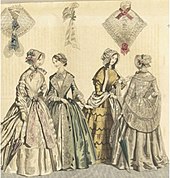
In the 1840s, collapsed sleeves, low necklines, elongated V-shaped bodices, and fuller skirts characterised the dress styles of women.
At the get-go of the decade, the sides of bodices stopped at the natural waistline, and met at a indicate in the front. In accord with the heavily boned corset and seam lines on the bodice likewise, the popular low and narrow waist was thus accentuated.
Sleeves of bodices were tight at the acme, because of the Mancheron,[5] but expanded around the area betwixt the elbow and before the wrist. It was besides initially placed below the shoulder, notwithstanding; this restricted the movements of the arm.[5]
As a upshot, the middle of the decade saw sleeves flaring out from the elbow into a funnel shape; requiring undersleeves to be worn in order to embrace the lower arms.[6]
Skirts lengthened, while widths increased due to the introduction of the horsehair crinoline in 1847; becoming a condition symbol of wealth.
Extra layers of flounces and petticoats, also further emphasised the fullness of these wide skirts. In compliance with the narrow waist though, skirts were therefore attached to bodices using very tight organ pleats secured at each fold.[five] This served every bit a decorative element for a relatively evidently skirt. The 1840s style was perceived as bourgeois and "Gothic" compared to the flamboyance of the 1830s.[vii]
1850s dress style

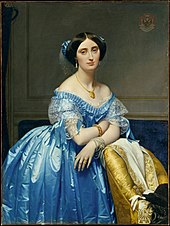

A similar silhouette remained in the 1850s, while certain elements of garments changed.
Necklines of twenty-four hours dresses dropped even lower into a V-shape, causing a need to embrace the bosom expanse with a chemisette. In dissimilarity, evening dresses featured a Bertha, which completely exposed the shoulder area instead. Bodices began to extend over the hips, while the sleeves opened farther and increased in fullness. The volume and width of the skirt connected to increment, specially during 1853, when rows of flounces were added.
Nevertheless, in 1856, skirts expanded even farther; creating a dome shape, due to the invention of the get-go artificial muzzle crinoline. The purpose of the crinoline was to create an bogus hourglass silhouette by accentuating the hips, and fashioning an illusion of a small waist; along with the corset. The cage crinoline was synthetic past joining thin metallic strips together to class a circular structure that could solely back up the large width of the skirt. This was made possible by technology which allowed iron to be turned into steel, which could and then exist drawn into fine wires.[ane] Although often ridiculed by journalists and cartoonists of the time as the crinoline swelled in size, this innovation freed women from the heavy weight of petticoats and was a much more than aseptic choice.[seven]
Meanwhile, the invention of synthetic dyes added new colours to garments and women experimented with gaudy and bright colours. Technological innovation of 1860s provided women with freedom and choices.[1]
1860s dress fashion
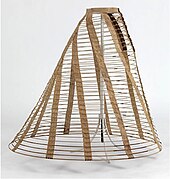

1860s apparel featuring a train

During the early and middle 1860s, crinolines began decreasing in size at the meridian, while retaining their aamplitude at the bottom.[8] In contrast, the shape of the crinoline became flatter in the front and more than voluminous behind, as it moved towards the back since skirts consisted of trains now. Bodices on the other hand, ended at the natural waistline, had wide pagoda sleeves, and included high necklines and collars for day dresses; low necklines for evening dresses. However, in 1868, the female silhouette had slimmed downwardly every bit the crinoline was replaced past the hurry, and the supporting flounce overtook the function of determining the silhouette.[9] Skirt widths diminished even further, while fullness and length remained at the back. In order to emphasise the dorsum, the train was gathered together to form soft folds and draperies[10]
1870s dress way

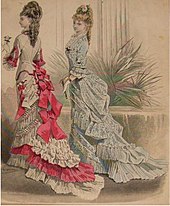
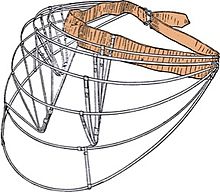
The tendency for broad skirts slowly disappeared during the 1870s, as women started to prefer an even slimmer silhouette. Bodices remained at the natural waistline, necklines varied, while sleeves began under the shoulder line. An overskirt was commonly worn over the bodice, and secured into a large bow behind. Over time though, the overskirt shortened into a discrete basque, resulting in an elongation of the bodice over the hips. Equally the bodices grew longer in 1873, the polonaise was thus introduced into the Victorian dress styles. A polonaise is a garment featuring both an overskirt and bodice together. The tournure was also introduced, and along with the polonaise, it created an illusion of an exaggerated rear stop.
By 1874, skirts began to taper in the front and were adorned with trimmings, while sleeves tightened around the wrist area. Towards 1875 to 1876, bodices featured long but even tighter laced waists, and converged at a sharp point in forepart. Bustles lengthened and slipped even lower, causing the fullness of the skirt to farther diminish. Extra textile was gathered together backside in pleats, thus creating a narrower just longer tiered, draped railroad train too. Due to the longer trains, petticoats had to be worn underneath in order to keep the apparel clean.
Notwithstanding, when 1877 approached, dresses moulded to fit the figure,[8] equally increasing slimmer silhouettes were favoured. This was allowed by the invention of the cuirass bodice which functions like a corset, but extends downwards to the hips and upper thighs. Although dress styles took on a more natural class, the narrowness of the skirt express the wearer in regards to walking.
1880s dress style

A Victorian swell pictured in the 1840s

The early 1880s was a period of stylistic confusion.[i] On 1 hand, there is the over-ornamented silhouette with contrasting texture and frivolous accessories. On the other hand, the growing popularity of tailoring gave ascent to an culling, severe style.[seven] Some credited the alter in silhouette to the Victorian wearing apparel reform, which consisted of a few movements including the Artful Costume Movement and the Rational Dress Movement in the mid-to-tardily Victorian Era advocating natural silhouette, lightweight underwear, and rejecting tightlacing. Nonetheless, these movements did non gain widespread support. Others noted the growth in cycling and lawn tennis equally acceptable feminine pursuits that demanded a greater ease of movement in women's vesture.[ane] Still others argued that the growing popularity of tailored semi-masculine suits was but a stylish style, and indicated neither avant-garde views nor the need for practical clothes.[7] Nevertheless, the diversification in options and adoption of what was considered menswear at that time coincided with growing power and social status of women towards the late-Victorian period.
The hurry made a re-advent in 1883, and it featured a further exaggerated horizontal protrusion at the back. Due to the additional fullness, drapery moved towards the sides or front end console of the skirt instead. Any drapery at the back was lifted upwardly into poufs. Bodices on the other hand, shortened and ended above the hips. All the same the style remained tailored, just was more than structured.
However, by 1886, the silhouette transformed back to a slimmer figure once again. Sleeves of bodices were thinner and tighter, while necklines became higher once again. Furthermore, an even farther tailored-await began to develop until it improved in the 1890s.
1890s apparel style
Past 1890, the crinoline and hurry was fully abandoned, and skirts flared away naturally from the wearer's tiny waist. It evolved into a bell shape, and were fabricated to fit tighter around the hip area. Necklines were high, while sleeves of bodices initially peaked at the shoulders, but increased in size during 1894. Although the big sleeves required cushions to secure them in identify, it narrowed down towards the cease of the decade. Women thus adopted the way of the tailored jacket, which improved their posture and confidence, while reflecting the standards of early female person liberation.
Hats


Hats were crucial to a respectable advent for both men and women. To become bareheaded was simply non proper. The superlative hat, for instance, was standard formal wear for upper- and middle-grade men.[7] For women, the styles of hats inverse over time and were designed to match their outfits.
During the early Victorian decades, voluminous skirts held upwards with crinolines, and and then hoop skirts, were the focal point of the silhouette. To enhance the fashion without distracting from it, hats were modest in size and design, straw and fabric bonnets being the popular choice. Poke bonnets, which had been worn during the late Regency period, had high, small crowns and brims that grew larger until the 1830s, when the confront of a adult female wearing a poke bonnet could only be seen directly from the front. They had rounded brims, echoing the rounded form of the bell-shaped hoop skirts.
The silhouette changed once once again as the Victorian era drew to a close. The shape was substantially an inverted triangle, with a wide-brimmed chapeau on top, a total upper body with puffed sleeves, no bustle, and a skirt that narrowed at the ankles[11] (the hobble brim was a fad shortly afterward the end of the Victorian era). The enormous wide-brimmed hats were covered with elaborate creations of silk flowers, ribbons, and above all, exotic plumes; hats sometimes included entire exotic birds that had been stuffed. Many of these plumes came from birds in the Florida everglades, which were nearly made entirely extinct by overhunting. By 1899, early environmentalists similar Adeline Knapp were engaged in efforts to curtail the hunting for plumes. By 1900, more than v one thousand thousand birds a yr were existence slaughtered, and well-nigh 95 per centum of Florida's shore birds had been killed by feather hunters.[12]
Shoes
The women's shoes of the early Victorian flow were narrow and heelless, in black or white satin. By 1850s and 1860s, they were slightly broader with a low heel and made of leather or cloth. Talocrural joint-length laced or buttoned boots were besides popular. From the 1870s to the twentieth century, heels grew higher and toes more pointed. Depression-cut pumps were worn for the evening.[7]
Men'south fashion

Drawing of Victorian men 1870s
During the 1840s, men wore tight-plumbing equipment, calf length frock coats and a waistcoat or belong. The vests were single- or double-breasted, with shawl or notched collars, and might be finished in double points at the lowered waist. For more than formal occasions, a cutaway morning coat was worn with light trousers during the daytime, and a dark tail coat and trousers was worn in the evening. Shirts were made of linen or cotton with low collars, occasionally turned downward, and were worn with broad cravats or neck ties. Trousers had fly fronts, and breeches were used for formal functions and when horseback riding. Men wore top hats, with wide brims in sunny atmospheric condition.
During the 1850s, men started wearing shirts with high upstanding or turnover collars and four-in-paw neckties tied in a bow, or tied in a knot with the pointed ends sticking out similar "wings". The upper-class continued to wear top hats, and bowler hats were worn by the working class.
In the 1860s, men started wearing wider neckties that were tied in a bow or looped into a loose knot and fastened with a stickpin. Apron coats were shortened to articulatio genus-length and were worn for business concern, while the mid-thigh length sack coat slowly displaced the frock glaze for less-formal occasions. Top hats briefly became the very tall "stovepipe" shape, but a variety of other hat shapes were pop.
During the 1870s, three-piece suits grew in popularity along with patterned fabrics for shirts. Neckties were the four-in-hand and, later, the Ascot ties. A narrow ribbon necktie was an alternative for tropical climates, particularly in the Americas. Both frock coats and sack coats became shorter. Flat straw boaters were worn when canoeing.
During the 1880s, formal evening dress remained a dark tail glaze and trousers with a night waistcoat, a white bow necktie, and a shirt with a winged neckband. In mid-decade, the dinner jacket or tuxedo, was used in more than relaxed formal occasions. The Norfolk jacket and tweed or woolen breeches were used for rugged outdoor pursuits such as shooting. Human knee-length topcoats, often with contrasting velvet or fur collars, and calf-length overcoats were worn in winter. Men's shoes had higher heels and a narrow toe.
Starting from the 1890s, the blazer was introduced, and was worn for sports, sailing, and other coincidental activities.[13]
Throughout much of the Victorian era most men wore adequately short pilus. This was frequently accompanied by diverse forms of facial hair including moustaches, side-burns, and full beards. A clean-shaven face did non come dorsum into fashion until the end of the 1880s and early 1890s.[xiv]
Distinguishing what men really wore from what was marketed to them in periodicals and advertisements is problematic, every bit reliable records do not exist.[fifteen]
Mourning black

Victoria's five daughters (Alice, Helena, Beatrice, Victoria and Louise), photographed wearing mourning blackness beneath a bust of their tardily father, Prince Albert (1862)

In U.k., black is the colour traditionally associated with mourning for the expressionless. The customs and etiquette expected of men, and peculiarly women, were rigid during much of the Victorian era. The expectations depended on a complex hierarchy of close or distant human relationship with the deceased. The closer the human relationship, the longer the mourning catamenia and the wearing of black. The wearing of total black was known as Commencement Mourning, which had its own expected attire, including fabrics, and an expected elapsing of 4 to 18 months. Following the initial period of First Mourning, the mourner would progress to 2d Mourning, a transition period of wearing less black, which was followed by Ordinary Mourning, and so One-half-mourning. Some of these stages of mourning were shortened or skipped completely if the mourner's relationship to the deceased was more distant. One-half-mourning was a transition period when black was replaced by acceptable colours such every bit lavander and mauve, perchance considered acceptable transition colours because of the tradition of Church of England (and Cosmic) clergy wearing lavander or mauve stoles for funeral services, to stand for the Passion of Christ.[16]
The mourning dress on the right was worn past Queen Victoria, "it shows the traditional touches of mourning attire, which she wore from the death of her married man, Prince Albert (1819–1861), until her ain death."[17]
Norms for mourning
Manners and Rules of Practiced Society, or, Solecisms to be Avoided (London, Frederick Warne & Co., 1887) gives clear instructions, such equally the following:[18]
| Relationship to deceased | First mourning | 2nd mourning | Ordinary mourning | Half-mourning |
|---|---|---|---|---|
| Wife for hubby | 1-twelvemonth, one-month; bombazine cloth covered with crepe; widow's cap, backyard cuffs, collars | vi months: less crepe | 6 months: no crepe, silk or wool replaces bombazine; in last 3 months jet jewellery and ribbons can be added | vi months: colours permitted are grey, lavender, mauve, and black-and-grey |
| Daughter for parent | 6 months: black with blackness or white crepe (for immature girls); no linen cuffs and collars; no jewellery for kickoff 2 months | iv months: less crepe | – | ii months as in a higher place |
| Wife for husband's parents | 18 months in blackness bombazine with crepe | – | 3 months in black | 3 months every bit above |
| Parent for son- or daughter-in-law'due south parent | – Blackness armband in representation of someone lost | – | i-month blackness | – |
| 2nd wife for parent of a first wife | – | – | 3 months blackness | – |
The complexity of these etiquette rules extends to specific mourning periods and attire for siblings, step-parents, aunts and uncles distinguished by claret and past union, nieces, nephews, first and second cousins, children, infants, and "connections" (who were entitled to ordinary mourning for a period of "1–three weeks, depending on level of intimacy"). Men were expected to clothing mourning blackness to a bottom extent than women, and for a shorter mourning period. Afterwards the mid-19th century, men would article of clothing a black hatband and black suit, but for merely half the prescribed period of mourning expected of women. Widowers were expected to mourn for a mere three months, whereas the proper mourning catamenia expected for widows was up to 4 years.[19] Women who mourned in blackness for longer periods were accorded great respect in public for their devotion to the departed, the most prominent example being Queen Victoria herself.
Women with bottom fiscal means tried to keep upwards with the example being set by the middle and upper classes by dyeing their daily dress. Dyers fabricated most of their income during the Victorian catamenia by dyeing dress black for mourning.[20]
Technological advocacy
Technological advancements not only influenced the economy but brought a major alter in the fashion styles worn by men and women. As the Victorian era was based on the principles of gender, race and grade.[21] Much advancement was in favor of the upper grade as they were the ones who could afford the latest technology and modify their fashion styles accordingly. In 1830s there was introduction of horse hair crinoline that became a symbol of status and wealth as only the upper-grade women could wear it. In 1850s there were more fashion technological advancements hence 1850s could rightly exist chosen a revolution in the Victorian fashion industry such equally the innovation of artificial cage crinoline that gave women an artificial hourglass silhouette this meant that women did non have to clothing layers of petticoats anymore to attain illusion of broad hips and it was also hygienic.[22] Synthetic dyes were also introduced that added new bright colours to garments. These technological advancement gave women freedom and choices. In 1855'southward Haute couture was introduced every bit tailoring became more mainstream in years to follow.[23]
Charles Frederick Worth, a prominent English designer, became popular amongst the upper class though its city of destiny e'er is Paris. Haute couture became pop at the same fourth dimension when sewing machines were invented.[24] Hand sewn techniques arose and were a distinction in compared to the old ways of tailoring. Princess Eugenie of France wore the Englishman dressmaker, Charles Frederick Worth's couture and he instantly became famous in France though he had just arrived in Paris a few years ago. In 1855, Queen Victoria and Prince Albert of Uk welcomed Napoleon 3 and Eugenie of French republic to a full state visit to England. Eugenie was considered a fashion icon in France. She and Queen Victoria became instant friends. Queen Victoria, who had been the mode icon for European high manner, was inspired past Eugenie'due south mode and the fashions she wore. Later Queen Victoria also appointed Charles Frederick Worth as her dress maker and he became a prominent designer amidst the European upper course. Charles Frederick Worth is known equally the male parent of the haute couture equally afterwards the concept of labels were also invented in the tardily 19th century as custom, made to fit tailoring became mainstream.[25]
By the 1860s, when Europe was all about fabricated-to-fit tailoring, crinolines were considered impractical. In the 1870s, women preferred more slimmer silhouettes, hence bodices grew longer and the polonaise, a skirt and bodice made together, was introduced. In 1870s the Cuirass Bodice, a piece of armour that covers the torso and functions like a corset, was invented. Towards the cease of Victoria'south reign, dresses were flared naturally every bit crinolines were rejected by eye-class women. Designers such equally Charles Frederick Worth were also confronting them. All these inventions and changes in fashion led to women'southward liberation as tailored looks improved posture and were more practical.[24]
Home décor
Home decor started spare, veered into the elaborately draped and decorated manner nosotros today regard as Victorian, then embraced the retro-chichi of William Morris likewise as pseudo-Japonaiserie.
Contemporary stereotypes
Victorian Modesty

"The proper length for little girls' skirts at various ages", from Harper'south Bazaar, showing a 1900 thought of how the hemline should descend towards the ankle equally a daughter got older
Many myths and exaggerations about the menses persist to the mod twenty-four hours. Examples include the thought of men's clothing is seen equally formal and stiff, women's as elaborate and over-done; wear covered the entire body, and fifty-fifty the glimpse of an ankle was scandalous. Critics contend that corsets constricted women's bodies and women's lives. Homes are described every bit gloomy, dark, cluttered with massive and over-ornate furniture and proliferating bric-a-brac. Myth has information technology that even piano legs were scandalous, and covered with tiny pantalettes.
In truth, men's formal wear may have been less colourful than it was in the previous century, but brilliant waistcoats and cummerbunds provided a affect of colour, and smoking jackets and dressing gowns were often of rich Oriental brocades. This miracle was the effect of the growing textile manufacturing sector, developing mass production processes, and increasing attempts to marketplace fashion to men.[15] Corsets stressed a woman'due south sexuality, exaggerating hips and bosom by contrast with a tiny waist. Women's evening gowns bared the shoulders and the tops of the breasts. The bailiwick of jersey dresses of the 1880s may accept covered the body, but the stretchy novel fabric fit the body like a glove.[26]
Home furnishing was non necessarily ornate or overstuffed. However, those who could beget lavish draperies and expensive ornaments, and wanted to brandish their wealth, would often do and then. Since the Victorian era was i of increased social mobility, there were ever more nouveaux riches making a rich show.
The items used in decoration may also have been darker and heavier than those used today, simply as a matter of practicality. London was noisy and its air was full of soot from countless coal fires. Hence those who could beget it draped their windows in heavy, sound-muffling curtains, and chose colours that didn't show soot chop-chop. When all washing was washed past hand, curtains were not washed as ofttimes as they might be today.
There is no actual evidence that piano legs were considered scandalous. Pianos and tables were often draped with shawls or cloths—but if the shawls hid anything, it was the cheapness of the furniture. There are references to lower-middle-grade families covering upwardly their pino tables rather than testify that they couldn't afford mahogany. The piano leg story seems to have originated in the 1839 book, A Diary in America written by Helm Frederick Marryat, as a satirical comment on American prissiness.[27]
Victorian manners may take been as strict equally imagined—on the surface. Ane simply did not speak publicly about sexual practice, childbirth, and such matters, at least in the respectable middle and upper classes. However, as is well known, discretion covered a multitude of sins. Prostitution flourished. Upper-class men and women indulged in adulterous liaisons.
Gallery
-

A mid-Victorian interior: Hide and Seek by James Tissot, c. 1877
-

-

-

-

Meet besides
- Victorian wearing apparel reform
- Women in the Victorian Era
- Victorian morality
- Charles Frederick Worth
- Victorian decorative arts
- Victoriana
Time periods
- 1830s in fashion
- 1840s in manner
- 1850s in fashion
- 1860s in fashion
- 1870s in way
- 1880s in fashion
- 1890s in manner
Women's clothing
- Corset
- Corset controversy
- Tightlacing
- Bloomers
- Bodice
Gimmicky interpretations
- Steampunk
- Neo-Victorian
- Lolita
References
- ^ a b c d e f Breward, Christopher (1995). The Culture of Fashion. Manchester University Press. pp. 145–180.
- ^ "Gender roles in the 19th century". The British Library . Retrieved 21 Oct 2016.
- ^ Gernsheim, Alison (1963). Victorian and Edwardian Way - A Photographic Survey. New York: Dover Publications Inc. p. 26.
- ^ a b Goldthorpe, Caroline (1988). From Queen to Empress - Victorian Dress 1837-1877. New York: The Metropolitan Museum of Fine art. pp. 23–24.
- ^ a b c Goldthorpe, Caroline (1988). From Queen to Empress - Victorian Dress 1837-1877. New York: The Metropolitan Museum of Art. p. 32.
- ^ Goldthorpe, Caroline (1988). From Queen to Empress - Victorian Dress 1837-1877. New York: The Metropolitan Museum of Art. p. 39.
- ^ a b c d e f Steele, Valerie (1985). Victorian Fashion. Style and Eroticism: Ideals of Feminine Dazzler from the Victorian Era to the Jazz Historic period . Oxford Academy Press. pp. 51–84.
- ^ a b Goldthorpe, Caroline (1988). From Queen to Empress - Victorian Dress 1837-1877. New York: The Metropolitan Museum of Art. p. 26.
- ^ Goldthorpe, Caroline (1988). From Queen to Empress - Victorian Dress 1837-1877. New York: The Metropolitan Museum of Fine art. p. 45.
- ^ Audin, Heather (2015). Making Victorian Costumes for Women. Crowood. p. 45.
- ^ Laver, James (2002). Costume and Fashion: A Concise History. London: Thames & Hudson Ltd. pp. 224–5. ISBN978-0-500-20348-4.
- ^ "Everglades National Park". PBS. Retrieved 7 November 2011.
- ^ Landow, George. "Men'due south breezy sporting dress, belatedly 1880s and '90s".
- ^ "Victorian Men's Fashions, 1850–1900: Hair".
- ^ a b Shannon, Brent (2004). "Refashioning Men: Mode, Masculinity, and the Cultivation of the Male Consumer in Britain, 1860–1914". Victorian Studies. 46 (four): 597–630. doi:10.1353/vic.2005.0022.
- ^ "The Colors of the Church Twelvemonth". Consortium of Country Churches. Retrieved vi November 2011.
- ^ The Metropolitan Museum of Art (vii September 2019). "Mourning Apparel, 1894–95". The Metropolitan Museum of Art . Retrieved 7 September 2019.
- ^ Flanders, Judith (2003). The Victorian Business firm. London: Harper Perennial. pp. 378–83. ISBN0-00-713189-v.
- ^ Flanders, Judith (2003). The Victorian Business firm. London: Harper Perennial. pp. 378–9. ISBN0-00-713189-five.
- ^ Flemish region, Judith (2003). The Victorian House. London: Harper Perennial. p. 341. ISBN0-00-713189-v.
- ^ Graham, P. "The Victorian Era". Digital Library of Republic of india.
- ^ Shrimpton, J. Victorian Fashion. Bloomsbury Shire Publications.
- ^ Aspelund, Karl. Fashioning Society. Fairchild Books.
- ^ a b Martin, Richard; Koda, Harold. Haute Couture. The Metropolitan Museum of Fine art.
- ^ Saillard, Olivier; Zazzo, Anne. Paris Haute Couture. Skira Flammarion.
- ^ Gernsheim, Alison (1981). Victorian & Edwardian Fashion: A Photographic Survey (New ed.). New York: Dover Publications. p. 65. ISBN0-486-24205-half dozen.
- ^ Marryat, C.B. (1839). A Diary in America: With Remarks on Its Institutions. Vol. 2. London, England: Longman, Orme, Brownish, Light-green, and Longmans. pp. 246–247. From pp. 246-247: "I was requested by a lady to escort her to a seminary for young ladies, and on beingness ushered into the reception-room, excogitate my astonishment at beholding a square piano-forte with 4 limbs. Notwithstanding, that the ladies who visited their daughters, might feel in its full forcefulness the extreme delicacy of the mistress of the establishment, and her care to preserve in their utmost purity the ideas of the young ladies under her charge, she had dressed all these four limbs in modest piffling trousers, with frills at the bottom of them!"
Further reading
- Phipps, Elena; et al. (1988). From Queen to Empress: Victorian apparel 1837-1877 . New York: The Metropolitan Museum of Art. ISBN0870995340.
- Sweetness, Matthew – Inventing the Victorians, St. Martin'southward Press, 2001 ISBN 0-312-28326-ane
External links
- Victorian Style
- VictorianVoices.net – Fashion articles and illustrations from Victorian periodicals; extensive style image gallery
- Victorian myths
- Victorian way, etiquette, and sports
- Background on "A Diary in America"
- Form and Fashion — the evolution of women's dress during the 19th century (many photographs)
- Educational Game: Mix and Friction match — build a 19th-century dress using a virtual mannequin
- "Victorian Dress". Fashion, Jewellery & Accessories. Victoria and Albert Museum. Retrieved 3 Apr 2011.
- Manner detective: Way, Fiction and Forensics in nineteenth century Australian manner on Culture Victoria
0 Response to "Victorian Fashion Victorian Vs Edwardian Fashion"
Post a Comment